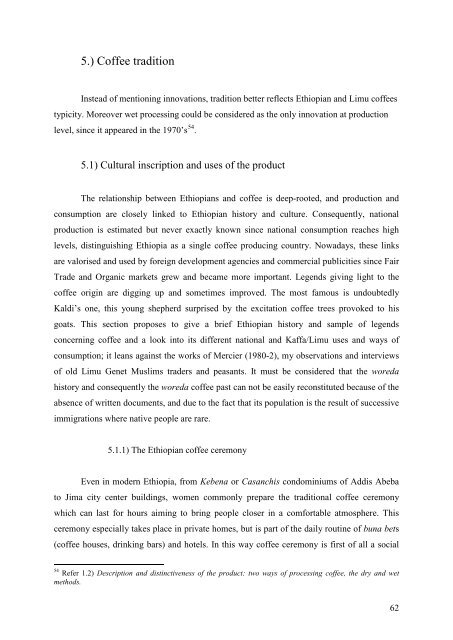A study case on coffee (Coffea arabica): Limu Coffe - IRD
A study case on coffee (Coffea arabica): Limu Coffe - IRD
A study case on coffee (Coffea arabica): Limu Coffe - IRD
Create successful ePaper yourself
Turn your PDF publications into a flip-book with our unique Google optimized e-Paper software.
5.) <strong>Coffe</strong>e traditi<strong>on</strong><br />
Instead of menti<strong>on</strong>ing innovati<strong>on</strong>s, traditi<strong>on</strong> better reflects Ethiopian and <strong>Limu</strong> <strong>coffee</strong>s<br />
typicity. Moreover wet processing could be c<strong>on</strong>sidered as the <strong>on</strong>ly innovati<strong>on</strong> at producti<strong>on</strong><br />
level, since it appeared in the 1970’s 54<br />
.<br />
5.1) Cultural inscripti<strong>on</strong> and uses of the product<br />
The relati<strong>on</strong>ship between Ethiopians and <strong>coffee</strong> is deep-rooted, and producti<strong>on</strong> and<br />
c<strong>on</strong>sumpti<strong>on</strong> are closely linked to Ethiopian history and culture. C<strong>on</strong>sequently, nati<strong>on</strong>al<br />
producti<strong>on</strong> is estimated but never exactly known since nati<strong>on</strong>al c<strong>on</strong>sumpti<strong>on</strong> reaches high<br />
levels, distinguishing Ethiopia as a single <strong>coffee</strong> producing country. Nowadays, these links<br />
are valorised and used by foreign development agencies and commercial publicities since Fair<br />
Trade and Organic markets grew and became more important. Legends giving light to the<br />
<strong>coffee</strong> origin are digging up and sometimes improved. The most famous is undoubtedly<br />
Kaldi’s <strong>on</strong>e, this young shepherd surprised by the excitati<strong>on</strong> <strong>coffee</strong> trees provoked to his<br />
goats. This secti<strong>on</strong> proposes to give a brief Ethiopian history and sample of legends<br />
c<strong>on</strong>cerning <strong>coffee</strong> and a look into its different nati<strong>on</strong>al and Kaffa/<strong>Limu</strong> uses and ways of<br />
c<strong>on</strong>sumpti<strong>on</strong>; it leans against the works of Mercier (1980-2), my observati<strong>on</strong>s and interviews<br />
of old <strong>Limu</strong> Genet Muslims traders and peasants. It must be c<strong>on</strong>sidered that the woreda<br />
history and c<strong>on</strong>sequently the woreda <strong>coffee</strong> past can not be easily rec<strong>on</strong>stituted because of the<br />
absence of written documents, and due to the fact that its populati<strong>on</strong> is the result of successive<br />
immigrati<strong>on</strong>s where native people are rare.<br />
5.1.1) The Ethiopian <strong>coffee</strong> cerem<strong>on</strong>y<br />
Even in modern Ethiopia, from Kebena or Casanchis c<strong>on</strong>dominiums of Addis Abeba<br />
to Jima city center buildings, women comm<strong>on</strong>ly prepare the traditi<strong>on</strong>al <strong>coffee</strong> cerem<strong>on</strong>y<br />
which can last for hours aiming to bring people closer in a comfortable atmosphere. This<br />
cerem<strong>on</strong>y especially takes place in private homes, but is part of the daily routine of buna bets<br />
(<strong>coffee</strong> houses, drinking bars) and hotels. In this way <strong>coffee</strong> cerem<strong>on</strong>y is first of all a social<br />
54<br />
Refer 1.2) Descripti<strong>on</strong> and distinctiveness of the product: two ways of processing <strong>coffee</strong>, the dry and wet<br />
methods.<br />
62

















